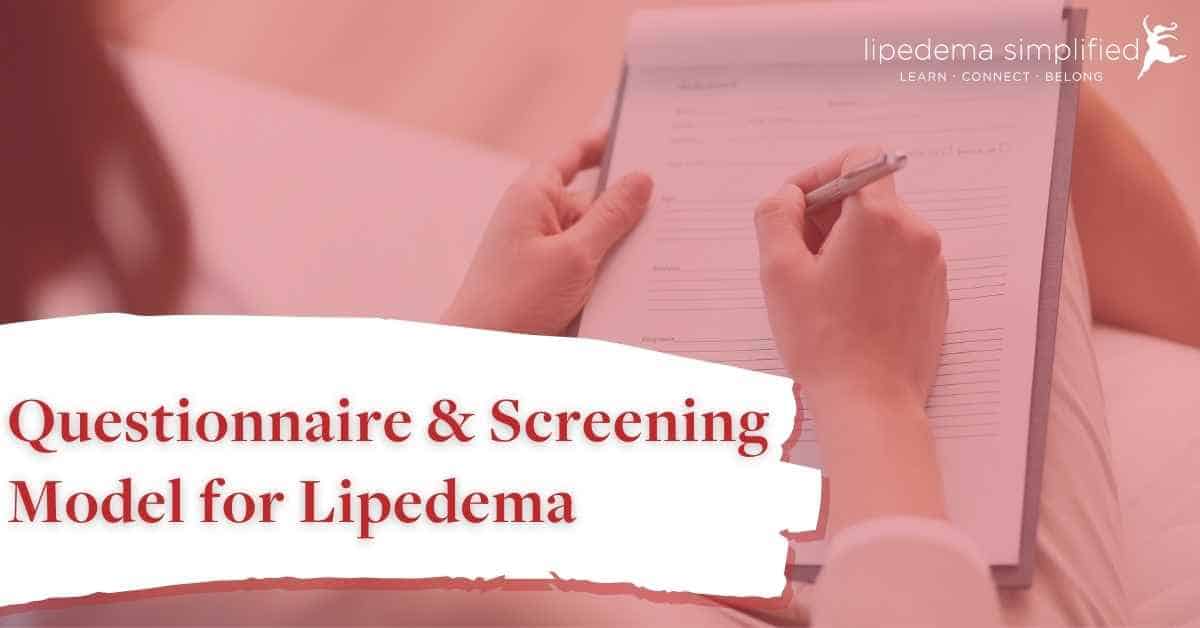
Today, I’d like to tell you about a study conducted by a group of physicians in São Paulo, Brazil that looked at developing a new way of screening for lipedema. Their article, “Development of a Questionnaire and Screening Model for Lipedema”, was published in the Journal Vascular Brasileiro in December 2020. The authors state that because there is such a dearth of objective diagnostic and screening tools for lipedema, not only in Brazil but worldwide, they worked to develop something that could be used to not only identify women who may have lipedema but also look at the key quality of life issues. The lead author, Dr. Alexandre Amato, spoke at our October 2021 Innovative Solutions for Lipedema & Lymphedema Virtual Symposium.
The Lipedema Screening Questionnaire
The physician authors of this paper are very supportive of our work at the Lipedema Project and I think they have developed an exceptional tool to aid in screening for lipedema. Their primary objective was to develop a simple and easy-to-fill-out questionnaire that could serve as a preliminary screen for lipedema. Secondly, they were curious to see if this screening tool could also be used as a model for mathematically predicting lipedema.
The Lipedema Screening Questionnaire is available in English as well as in Portuguese and Spanish. This questionnaire is a 9-question self-report survey, where each question is rated on a scale of 0-3. (To view the complete questionnaire, click here. The questionnaire can be found in Table 1.)
Method
The questionnaire was given to 109 women, of whom 59 had lipedema and 50 did not. The two groups were very similar in age (mid-40’s) and weight (80 kg. or 175 lbs.). In order to be accepted into the study, the participants must be female, at least 18 years old, not have any serious arterial or venous conditions, and be able to read and understand Portuguese. The women answered the questionnaire on their own using an online form (Survey Monkey).
Results
The authors reported that the participants understood all of the questions and took only approximately 4 minutes to complete the questionnaire. Based on their data, this tool has a high degree of accuracy for predicting lipedema with up to 91% accuracy for single questions and 86% accuracy for the total score.
Interestingly, the question with the highest degree of accuracy for a correct diagnosis was: “Do you feel that there is something wrong with your legs, but don’t know what it is?” The next most accurate predictor was “Do your legs hurt?” Two questions could not be used as a single question predictor because of too few positive answers. These had to do with the onset of symptoms at pregnancy or menopause, which we have seen anecdotally at least have common trigger periods in a woman’s life.
Takeaways
This is a simple, easy-to-use tool that will be excellent for use in not only lipedema and lymphedema clinics, but also by medical providers who may have heard about lipedema be unsure if their knowledge or experience is enough to confidently make a diagnosis of lipedema. Although a high score on this screening tool indicates a high probability for lipedema, it should not be used for a definitive diagnosis. This tool can, however, raise the suspicion of lipedema to such a degree that pursuing further efforts for diagnoses, such as patient history, physical examination, and referral for imaging or specialist consultation, would be justified.
I look forward to this questionnaire being available to clinicians around the world.
For more related content, be sure to check out Lipedema Simplified’s Flash Briefings, our daily mini-podcast with tips, tools, helpful research, and other resources pertaining to lipedema.
~ Leslyn Keith, OTD, CLT-LANA
Board President, Director of Research | The Lipedema Project
